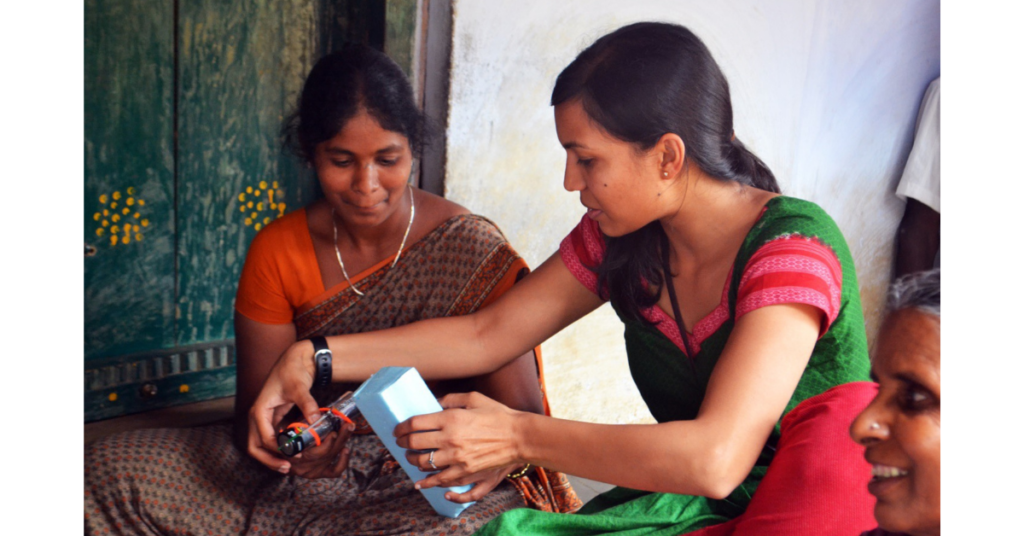Co-author: Saida Benhayoune and Amar Gokhale
This article is the second of a 2-part series that captures learnings from a ‘co-design’ exercise conducted with investors in India to help the move from intention to action on gender-inclusive investing. The co-design exercise comprised of five 3-hour sessions conducted virtually in October 2021. Please click here for the first article.
8 min read
The data is in – 2020 was another disappointing year for women-led startups. They received just 2.3% of global venture capital (VC) funding, the lowest amount recorded over the last five years. Despite the setbacks, there is a growing urgency to address the gender financing gap. New actors are stepping up and taking action. Increasingly, progressive VCs are turning their gaze inward, scrutinizing their portfolios and investment practices, and identifying ample room for improvement. Many are looking for practical pathways and actionable tools to increase their capacity to allocate capital and promote gender equity.
Can strategy tools help gender-intentional investors generate quick insights and shape better, fairer, and more inclusive investment practices?
We identified six funds working in India – Aavishkaar Capital, Acumen, Omidyar Network India, Accion Venture Lab, Villgro, and UC Impact – who were actively working to increase capital flows to women-led and gender-forward businesses. In October 2021, investors from these funds joined our “Co-design Sprint: Towards gender inclusive investment practices” to explore how they might improve sourcing, due diligence, and gender data practices to achieve their goals. In a virtual workshop series, MIT D-Lab and Intellecap placed the investors in design teams of 4-6 alongside ecosystem stakeholders, gender experts, and entrepreneurs and introduced them to co-design methods.
For each 3-hour workshop, we developed and tested a series of interactive exercises and visual tools to facilitate harnessing GLI insights for the six spotlight investors.
Generating new insights with strategy tools
Albert Einstein famously said that if he had an hour to save the world, he would spend 55 minutes understanding the problem and the last 5 minutes solving it. Most of the current GLI literature focuses on capturing best practices and packaging them into guidebooks, reports, and case studies that are mostly prescriptive. It focuses less on the problem framing space, leaving it up to practitioners to figure out what solutions are contextual and relevant to them. Yet it is not easy to know where to start if you have never done it before. Many investors we spoke to were casting a wide net, trying multiple strategies to make their investment practices more gender-inclusive, yet were seeing mixed results towards reaching desired outcomes.
How can we help investors identify the right problems to solve? We propose using strategy tools or visual canvasses and frameworks that help practitioners break down and reframe complex problems. So, issues like ‘I can’t recruit more female founders because I have a pipeline problem’ that seem intractable or paralyzing at the start, can be broken down to reveal bite-sized challenges and new opportunities for improvement. With this goal in mind, we created a series of sensemaking tools to help investors surface diverse perspectives and develop a shared understanding of where the challenges they need to address really lie. The set of actionable frameworks we developed are simple enough to sketch on MIRO — and powerful enough to help investors, female founders, and other stakeholders have focused exchanges that unlock pivotal insights around sourcing, due diligence, and data practices.
These types of strategy tools, more widely seen in business consulting or entrepreneurship circles, are especially helpful in communicating and organizing thoughts, collecting collaborative insights, creating inclusive designs, and ensuring alignment – which was a good match for the early-stage work that our six spotlight investors were doing in their funds.
We’d like to share the tool series, explain how we used them in each workshop, and invite you to try them to support your gender lens journey.
Workshop 1: Taking a customer-centric approach to sourcing women-led business
Accion Venture Lab and Villgro paired up for the Sourcing Workshop to tackle a common challenge: “How might we improve our sourcing practices to attract and identify more female-led ventures?” Women founders are different than male founders, and to attract them, investors can start by understanding what makes them different, then restructuring sourcing processes to work for their needs. We invited workshop participants to begin visualizing women entrepreneurs as a desirable new market segment. We leveraged two well-established design tools to generate insights: user personas and user journey maps. Investors developed user personas to drill down into the unique aspirations, challenges, needs, and desires of the women entrepreneurs they want to attract. Next, workshop participants filled out user journey maps, stepping into the shoes of female founders to pinpoint where and how existing sourcing practices exacerbate or create barriers to entry. The two empathy-building tools helped uncover a set of common gaps and opportunity spaces for GLI investors to address as they design or improve their sourcing practices. Taking a customer-centric approach offered investors new insights on how to adapt their messages, channels, positioning, and offering to attract and retain women-led businesses in their pipelines.
To make your sourcing inclusive, start by understanding who you want to attract into your pipeline, then anticipate and address the challenges they face when they navigate your recruitment process. Try out our GLI sourcing tools HERE.
Workshop 2: Identifying the ‘leaks’ or risk drivers in your Due Diligence Funnel
Aavishkaar Capital and Acumen paired together to explore “How might we improve our due diligence processes to better evaluate and select for female-led and gender-forward businesses?” Drawing inspiration from Hugh Macfarlane “Leaky Funnel”, we invited participants to visualize the due diligence cycle as an inverted pyramid divided into four closely related stages: screening, evaluation, negotiation, and approval. In design teams, participants were challenged to identify: Where along the due diligence process does the funnel ‘leak’, or ‘disproportionately eject’ female founders and gender-forward businesses? Which factors may be causing leaks in each due diligence stage? More specifically, we asked participants to consider three risk drivers: 1) WHAT criteria are used for selection? 2) WHO is involved and who has decision-making power? And 3) HOW are the processes implemented and monitored? By segmenting due diligence into discrete stages and examining risk factors that touched on the fund’s culture, underlying norms, decision-making processes, and potential exclusionary practices, the tool revealed multiple opportunities for investors to mitigate undesirable leakage (such as gender biases, blind spots, misaligned incentives) while maintaining desirable screens (continuing to successfully weed out unfit deals) to identify the best investment opportunities.
To make due diligence inclusive, break down the due diligence process in stages, create a heatmap to identify risk factors in your current processes, and uncover the drivers behind the risks. You can try out our GLI due diligence tools HERE.
Workshop 3: Leverage gender data to amplify value for the fund and entrepreneur
Omidyar Network India and UC Impower paired up in the Gender Data Workshop to explore: “How might we leverage gender data to create value for our fund and our portfolio companies?” We framed the workshop as an opportunity to optimize each investor’s data-gathering practices. We invited investors to ‘begin with the end in mind’ specifically asking: What value do your fund and your portfolio entrepreneurs expect to generate from gender data? How do these values line up, and how can they complement each other? To help organize brainstorming of opportunities, we developed the 6P Gender Data Bloom Canvas, which invites participants to explore a multitude of ways in which investors and entrepreneurs can leverage gender data to generate value in six categories: Product, Processes, People, Planning, Performance, and Positioning. By expanding the understanding of the opportunities that exist to create value from gender data, investors can become more intentional about what data needs to be collected and how to use it. Furthermore, the tool helps investors think about the value in a more holistic and strategic sense that goes beyond Environmental, Social, and Governance (ESG) or impact metrics monitoring.
To design a gender data strategy that yields powerful results without overburdening you and portfolio companies, start with a goal in mind. You can try out our GLI Data tools HERE.
The way forward
Through the co-design sprint, investors gained access to new frameworks and tools, fresh insights, promising idea starters, and new relationships – all of which can be further leveraged in their gender lens journey.
This experiment validated that strategy tools have enormous potential to propel investors from intentionality into action. These frameworks helped investors move away from one-size-fits-all gender mainstreaming approaches, better identify sourcing, due diligence, and gender data challenges inside their organizations by collecting multiple perspectives and begin to identify what levers they need to pull first to solve these challenges.
Paired with mindset exercises around bias, power, empathy-building, and guided by thoughtful facilitation, strategy tools have the potential to improve clarity and inclusiveness. When used to enter into conversation with female founders, strategy tools can help investors shed a light on hard to identify blind spots, unconscious biases, or long-standing organizational practices that may be blocking the achievement of desired gender outcomes. In opening up participation to include many voices, including the ones most affected, we can make new GLI practices vastly more inclusive, innovative, and effective.
Centering our co-design tools around gender equity helped us realize that imagining more inclusive investment processes is a journey, not a destination. As such, there is a lot more work to be done to translate existing best practices into a practitioner-friendly GLI tool library. Actionable strategy tools promise to accelerate innovation, reduce risk by identifying optimal levers for change, and increase the adoption of the best possible solutions that meet the needs of female founders, gender-forward businesses, and the funds themselves.


















